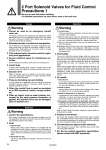
m-03-3c-seihin_en 59 / 77
10秒後にBOOKのページに移動します
2 Port Solenoid Valves for Fluid Control Precautions 1 Be sure to read this before handling. For detailed precautions on each series, refer to the main text. 1. Cannot be used as an emergency shutoff valve, etc. The valves presented in this catalog are not designed for safety applications such as an emergency shutoff valve. If the valves are used in this type of system, other reliable safety assurance measures should also be adopted. 2. Extended periods of continuous energization The solenoid coil will generate heat when continuously energized. Avoid using in a tightly shut container. Install it in a wellventilated area. Furthermore, do not touch it while it is being energized or after it is energized. 3. This solenoid valve cannot be used for explosion proof applications. 4. Ensure sufficient space for maintenance activities. When installing the products, allow access for maintenance. 5. Liquid rings In cases with a flowing liquid, provide a by-pass valve in the system to prevent the liquid from entering the liquid seal circuit. 6. Actuator drive When an actuator, such as a cylinder, is to be driven using a valve, take appropriate measures to prevent potential danger caused by actuator operation. 7. Pressure (including vacuum) holding It is not usable for an application such as holding the pressure (including vacuum) inside of a pressure vessel because air leakage is entailed in a valve. 8. When the conduit type is used as equivalent to an IP65 enclosure, install a wiring conduit, etc. 9. When an impact, such as water hammer, etc., caused by the rapid pressure fluctuation is applied, the solenoid valve may be damaged. Give an attention to it. Design Warning 1. Confirm the specifications. Give careful consideration to the operating conditions such as the application, fluid and environment, and use within the specified operating ranges in this catalog. 2. Fluid 1) Type of fluids Before using a fluid, confirm whether it is compatible with the materials from each model by referring to the fluids listed in this catalog. Use a fluid with a dynamic viscosity of 50 mm2/s or less. If there is something you do not know, please contact SMC. 2) Flammable oil, Gas, Confirm the specification for leakage in the interior and/or exterior area. Warning Selection 3) Corrosive gas Cannot be used since it will lead to cracks by stress corrosion or result in other incidents. 4) When a brass body is used, then depending on water quality, corrosion and internal leakage may occur. If such abnormalities occur, exchange the product for a stainless steel body. 5) Use an oil-free specification when any oily particle must not enter the passage. 6) Applicable fluid on the list may not be used depending on the operating condition. Give adequate confirmation, and then determine a model, just because the compatibility list shows the general case. 3. Fluid quality The use of a fluid that contains foreign matter can cause problems such as malfunction and seal failure by promoting wear of the valve seat and armature, and by sticking to the sliding parts of the armature, etc. Install a suitable filter (strainer) immediately upstream from the valve. As a general rule, use 80 to 100 mesh. When used to supply water to boilers, substances such as calcium and magnesium which generate hard scale and sludge are included. Since this scale and sludge can cause the valve to malfunction, install water softening equipment, and a filter (strainer) directly upstream from the valve to remove these substances. 4. Air quality 1) Use clean air. Do not use compressed air that contains chemicals, synthetic oils including organic solvents, salt or corrosive gases, etc., as it can cause damage or malfunction. 2) Install air filters. Install air filters close to valves at their upstream side. A filtration degree of 5 μm or less should be selected. 3) Install an aftercooler or air dryer, etc. Compressed air that contains excessive drainage may cause malfunction of valves and other pneumatic equipment. To prevent this, install an aftercooler or air dryer, etc. 4) If excessive carbon powder is generated, eliminate it by installing mist separators at the upstream side of valves. If excessive carbon powder is generated by the compressor, it may adhere to the inside of the valves and cause malfunction. Refer to SMC’s Best Pneumatics catalog for further details on compressed air quality. 5. Ambient environment Use within the operable ambient temperature range. Confirm the compatibility between the product’s composition materials and the ambient atmosphere. Be certain that the fluid used does not touch the external surface of the product. 6. Countermeasures against static electricity Take measures to prevent static electricity since some fluids can cause static electricity. 7. For the low particle generation specification, please consult with SMC separately. Warning Selection 54